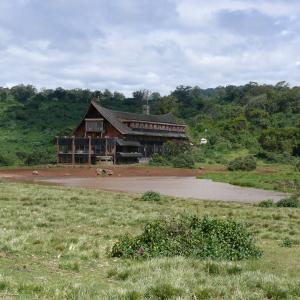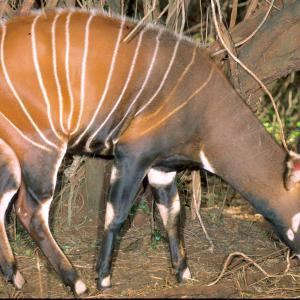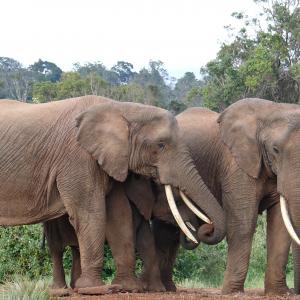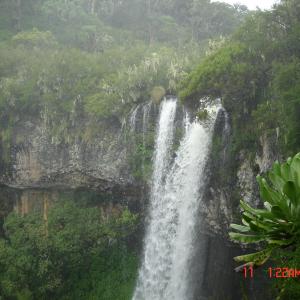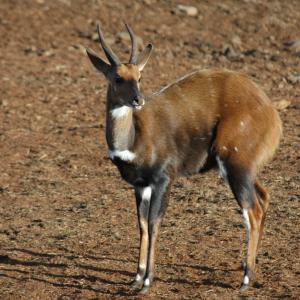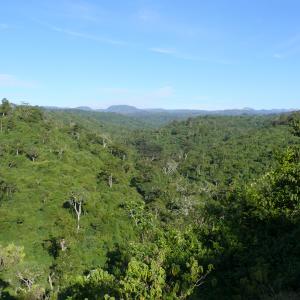``Highlands, moorlands, peaks and falls``

Encircled by the wild and beautiful moorlands of the third highest mountain range in Kenya, the Aberdare National Park offers a mist-wreathed realm where elephants roam through lichen-hung forests, spectacular waterfalls plunge into churning pools and trout-filled streams cascade through mossy dells. A Kenya safari haven for anglers, walkers and lovers of solitude alike, this atmospheric park plays host to several of Kenya’s most famous safari lodges and offers matchless vistas of the glittering coronet of Mount Kenya and the sparkling lakes of the Great Rift Valley. Aptly dubbed ‘Scotland with lions’ by the early settlers, the higher reaches of the national park offer mist-wreathed peaks, mountain hiking trails, crystal streams and cloud-shadowed moors. There are also quilted banks of tussock grass where quail and francolin scurry; icy tarns and silver-grey thickets where hunched ginger-brown reedbuck dart and a vast arc of tropical-blue sky patrolled by augur buzzard and sparrow hawk.
Kenya Safari Fact File
Altitude: 1,829-4,001 meters above sea level.
Area: 767 sq. km.
Location: Central Highlands west of Mount Kenya.
Distance from Nairobi: 160 km
Gazetted: The Aberdares was established in May 1950.
Geography: The Aberdare Range is a long narrow massif, stretching north to south for about 70km with its southern end about 80km north of Nairobi. Along the centre of the range are the main peaks: Chebuswa (3,364 m), Satima (4,001 m) and Table Mountain (3,791m) are in the Northern Moorland; Rurimueria (3,860 m) and Maratini (3,698 m) are in the Central Moorland and Kinangop (3,906 m) and The Elephant (3,590 m) are in the Southern Moorland.
Vegetation: The vegetation varies with altitude. A rich alpine and sub-alpine flora, including species of Senecio, Lobelia, Erica Helichrysum and tussock grasses, gives way at around 3,000 m to bamboo Arundinaria alpina and then montane rainforest (mainly Juniperus procera-Podocarpus falcatus-Nuxia congesta forest on the western and north-western slopes, Ocotea forest in the south-east and mixed Podocarpus latifolius forest in the east and on Kipipiri). Pockets of Hagenia forest also occur in sheltered patches on the rolling moorland.
Climate: Cool, misty and cloudy with heavy rain for much of the year. Precipitation varies from around 1,000 mm per annum on the drier north-western slopes to as much as 3,000 mm per annum in the south-east.
Fauna: Mammals of the forest zone include blue and colobus monkey, leopard, lion, elephant, warthog, black rhino, giant forest hog, bushbuck, buffalo, red duiker and suni. Mammals of the moorlands include serval, eland, several species of duiker and the rare bongo antelope.
Threatened species: Bongo, leopard, black rhinoceros, African elephant, giant forest hog and golden cat.
Endemic species: The Aberdare Mole-shrew and Aberdare Mole-rat, the Montane Viper (which occurs only here and on Mount Kenya) and the following amphibians (endemic to the central Kenyan highlands): Hyperolius montanus , H. cystocandicans , Rana witei and Phrynobatrachus kinangopensis . Endemic butterflies include: Neptis Kikuyuensis (endemic to the Aberdare Forest and the Kikuyu escarpment) and Charaxes nandina (endemic to central Kenya).
Birds: The prolific bird life features 250 recorded species.
Roads: Crisscrossed by a network of red ‘murram’ dirt roads and featuring a number of steep, rocky sections the park can often become inaccessible especially in the rainy season. 4WD vehicles are recommended.
What to do and see
The national park offers a number of safari lodges, perhaps the most famous of which is the Tree Tops Hotel as well as numerous hiking trails and camping sites. Activities include some of the best hiking trails in East Africa, fishing, nature walks, forest wildlife spotting and birding.
Spectacular water falls
The Park is renowned for its torrential waterfalls plunging from cloud-shrouded heights to spray-filled ravines. They include:
The Gura Waterfall , the most precipitous fall in Kenya, which cascades 300m into an impenetrable ravine, the spectacularly lovely Karura Falls , the Chania Falls and the Magura Falls and Queen’s Cave .
Excellent fishing in the cool mountain streams
Both brown and rainbow trout abound in the cool mountain streams and provide excellent angling. (A sports fishing license is required and can be obtained from the Park gates).
The Chania Falls picnic area
Close to the road, easy to find and offering a wide grassy clearing, wooden benches, a fast flowing stream and a timbered bridge, this picnic site also offers a short and mildly precipitous forest hiking trail leading alongside the river and then down the spray-filled ravine of the falls into the boulder-strewn plunge pool far below.
The Karura Falls viewing platform
A short walk from the road, down a sleep-sloping meadow full of giant lobelia and along a winding hiking trail where red-hot pokers, wild herbs and everlasting flowers bloom, lies what must be one of the most spectacular picnic sites in East Africa. Built out over the spectacular 275 m plunge of the Karura River are two broad, timbered viewing platforms constructed by the British army and equipped with safety rails and wooden benches, from which the view down the falls, across the ravine to the 300 m cascade of the Gura Falls, and along the length of the luxuriantly forested valley is breathtaking indeed.
The Magura Falls and Queens Cave pavilion
Built in 1952 for the royal picnic lunch of Queen Elizabeth II and her husband, Prince Phillip, the Queens Cave pavilion is a shingled gazebo fitted with a picnic table and benches looking out over the ravine of the Magura Falls. A short nature trail also leads down the valley and into the mouth of the Queen’s Cave, which extends into a dark fern filled pool beneath the cliffs, over which the force of the water cascades.
Trout fishing in the mountain streams
Trout were introduced into Kenya before the First World War but it was not until the 1930’s that extensive stocking got underway. Kenyan trout exhibit a very rapid growth rate and rainbows weighing up to 10 lbs have been caught. The best fishing areas are generally found above the 2,000 m level where the sparkling rivers drop down through mountain forests and open glades. You will also generally find that the higher the altitude, the smaller the fish.
Recommendation: Three rivers offering especially easy access and fine fishing within the Park are: the Amboni, the Chania and the Gura.
| Economy | |
| Comfort | The Ark |
| Luxury | Treetops Lodge |
